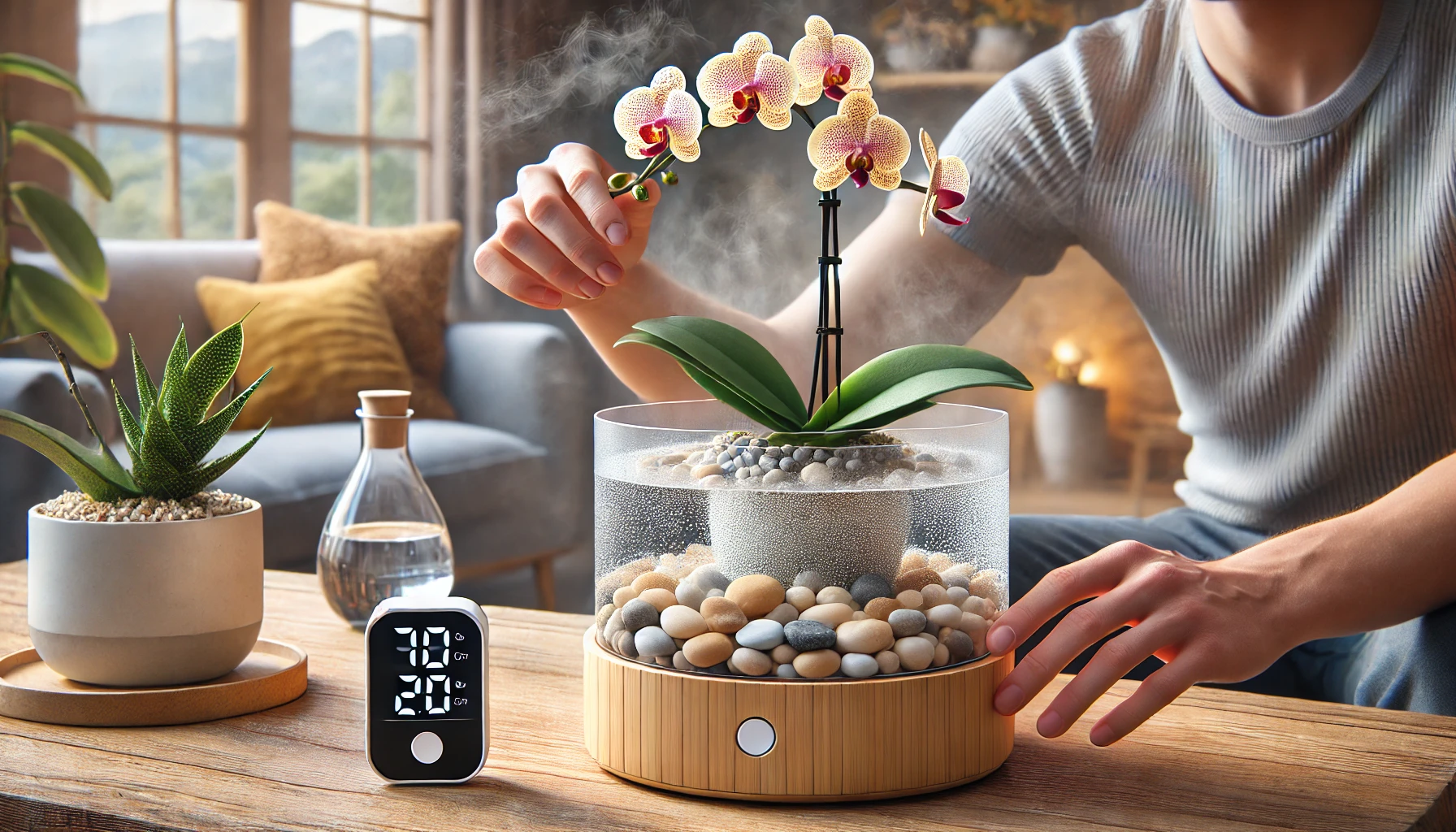Orchids thrive in humid environments, just like in their natural tropical habitats. However, indoor conditions—especially during winter or in air-conditioned rooms—can be too dry for them. When humidity levels drop below 50%, orchids may experience dry roots, wrinkled leaves, slow growth, and weak blooming.
A natural humidifier is an easy and cost-effective way to maintain the perfect humidity levels without using expensive electronic devices. By increasing moisture in the air around your orchids, you can help them stay hydrated and grow healthier.
🌿 Why Humidity is Important for Orchids
Orchids absorb moisture from both their roots and the air around them. In a dry environment, the plant loses moisture too quickly, leading to dehydration, slow root growth, and weak flower production.
✔ Signs That Your Orchid Needs More Humidity:
- Leaves become wrinkled or droopy, even with proper watering.
- Roots appear dry and silvery-white more often than usual.
- Flower buds drop before opening (bud blast).
- Leaf tips turn brown and crispy, especially in heated or air-conditioned rooms.
💡 Maintaining the right humidity prevents dehydration and supports strong, vibrant blooms!
🌫 How Much Humidity Do Orchids Need?
Different orchid species require varying levels of humidity.
✔ Recommended Humidity Levels for Common Orchids:
- Phalaenopsis (Moth Orchid): 50–70%
- Cattleya: 40–60%
- Dendrobium: 50–60%
- Vanda: 60–80% (loves high humidity)
- Oncidium: 55–75%
💡 Most orchids do well at around 50–70% humidity. If levels drop below 40%, moisture loss can occur quickly.
🌊 How to Make a Natural Humidifier for Orchids
There are several easy ways to increase humidity naturally around your orchids without using an electric humidifier.
🌿 1. Pebble Tray Humidifier (Best for All Orchids)
A humidity tray is one of the simplest and most effective ways to create a natural humidifier for your orchids.
✔ What You Need:
- A shallow tray or dish
- Small pebbles or decorative stones
- Water
✔ How to Set It Up:
1️⃣ Fill the tray with a layer of small pebbles.
2️⃣ Add water until it reaches just below the top of the pebbles (roots should not touch the water).
3️⃣ Place the orchid pot on top of the pebbles.
✔ How It Works:
- The water in the tray slowly evaporates, increasing humidity around the plant.
- The pebbles prevent the pot from sitting in standing water, which could cause root rot.
💡 Refill the tray when the water level drops, usually every few days.
🌿 2. Grouping Orchids Together (Microclimate Method)
Grouping multiple orchids or other houseplants creates a small humid microclimate where moisture is naturally retained.
✔ How to Do It:
- Arrange orchids close together, but with some space for airflow.
- Place a humidity tray in the center to increase moisture.
💡 This method works well in plant shelves, terrariums, or windowsill setups.
🌿 3. DIY Mist Spray (For Quick Humidity Boosts)
If your orchids need an instant humidity boost, you can lightly mist them with water.
✔ What You Need:
- A spray bottle
- Distilled or rainwater (tap water may leave mineral spots)
✔ How to Mist Your Orchid Properly:
1️⃣ Lightly spray the air around the orchid (not directly on the leaves or flowers).
2️⃣ Mist in the morning to allow moisture to evaporate during the day.
3️⃣ Avoid over-misting, as too much moisture can lead to fungal infections.
💡 This method is great for dry seasons but should not replace proper humidity control.
🌿 4. DIY Sponge Humidifier (For Small Spaces)
A damp sponge can act as a simple humidifier by slowly releasing moisture into the air.
✔ What You Need:
- A clean sponge
- A small bowl or dish
✔ How to Set It Up:
1️⃣ Dampen the sponge with clean water and place it in the bowl.
2️⃣ Set the bowl near your orchids, but not touching the roots.
3️⃣ Re-wet the sponge as needed to maintain humidity.
💡 This is a great method for small spaces or if you need a short-term humidity boost.
🌡 How to Monitor Humidity for Orchids
A hygrometer is the best tool to check humidity levels in your home.
✔ Best Humidity Monitor Setup:
- Place a digital hygrometer near your orchids to track moisture levels.
- If humidity drops below 40%, increase humidity using one of the natural methods above.
- If humidity is too high (above 80%), improve air circulation with a small fan.
💡 Stable humidity prevents orchid stress and keeps them growing strong.
🚫 Common Mistakes When Increasing Humidity
❌ Over-misting leaves – Can cause fungal infections or crown rot.
❌ Letting water touch roots in humidity trays – Leads to root rot.
❌ Creating too much moisture without airflow – Can invite fungus and mold.
❌ Placing orchids too close together – Can trap moisture and cause diseases to spread.
🛡 Final Tips for Maintaining the Right Humidity for Orchids
✔ Use a humidity tray to maintain a steady moisture level.
✔ Monitor humidity with a hygrometer to avoid extremes.
✔ Mist only when necessary, and do it in the morning.
✔ Ensure good airflow to prevent mold or fungus.
✔ Adjust humidity levels based on seasonal changes—dry winters often require more humidity support.
With the right humidity levels, your orchids will stay hydrated, produce strong roots, healthy leaves, and long-lasting blooms! 🌸✨
